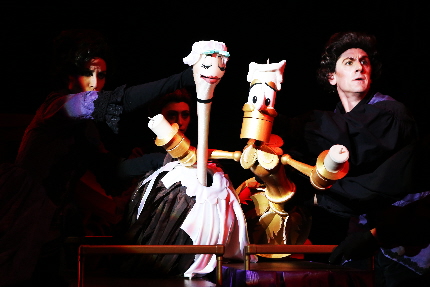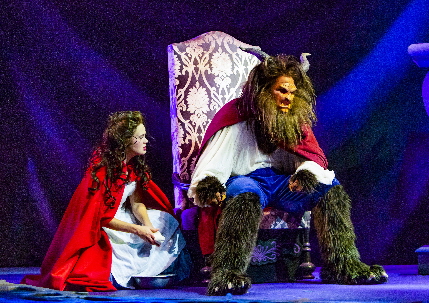
Alix Paige as Babette as Brendan Malafronte as Lumiere in the Maltz Jupiter Theatre’s Beauty and the Beast / Photos by Zak Bennett and Jason Nuttle
By Bill Hirschman
It’s unfair to the Maltz Jupiter Theatre’s Beauty and the Beast — which is as thoroughly charming on its own merits as you could ask — but understandable that the focus is diverted to its use of puppets to portray the enchanted household objects.
So, yes, the vision that Producing Artistic Director Andrew Kato and master puppeteer-dancer-actor and, in this case, director John Tartaglia came up with does indeed work, sometimes better than others.
Their idea, which lands solidly here, was to not put on a puppet show. Tartaglia, Tony-nominated for his work on Avenue Q, developed the idea of using the puppets as storytelling tools as seamlessly integrated as the lights and sound.
The rest of the show is the same as any of the editions since 1994 with strong voices, a superb band, fine choreography and solid staging – a typically faultless Maltz effort.
But here, although the puppeteers for Lumière, Cogsworth and Company are fully visible to the audience as in Warhorse and Avenue Q, the paradigm is completely different. These actors are not invisible manipulators; garbed in black and purple period costumes, they are acting through the puppets.
So standing and crouching behind the three-foot tall brass candlestick Lumière is deft puppeteer Brendan Malafronte emoting as fully as if the puppet wasn’t there.
The puppets were designed by Eric Wright and his Puppet Kitchen International staff who provided the shadow puppets for the Maltz’s The King and I and some of the denizens of The Wiz. In some cases, the creatures are surrealistically original and inventive such as the jaw-snapping wolves and the old beggar woman turning into the Enchantress in the prologue.
But for most of the household puppets, Wright and Tartaglia wisely echoed the designs of the Disney animators’ vision that audiences would insist upon seeing. With one exception, that means relatively stolid solid creatures; remember that in the film, their wood and brass bodies were animated as elastic as a bag of marbles, which cannot be done here.
The exception is the masterpiece of Lumière who looks exactly like the cartoon but is nimbly double-jointed and dexterous, with gesticulating arms and a body that bends over when in lust or excitement.
As Wright and Tartaglia acknowledge, they would just be pieces of machinery if not for the work of the puppeteers, some experienced like Malafronte and Paul Louis as Cogsworth, and others who have learned on the job.
But here’s the secret that makes the whole thing work: The characters come alive because the puppeteers are actors – their voices, facial expressions and body language are integral to the creation of their characters, to the point that the puppets are just an added bonus. This is subtly underscored in that the lighting design doesn’t hide their presence; often it pours directly onto the puppeteers’ faces. Cogsworth is just a fancy box with a mobile mouth. But Paul Louis’ voice and facial reactions make him a full character.
Again, the standout is Malafronte’s full-out acting performance as well as his advanced puppetry skills that makes the puppet into vibrant, kinetic nearly living thing. Malafronte is an experienced puppeteer whose lengthy theater credentials includes playing Lumière on a cruise ship revue.
Sometimes the magic is not as strong as you’d hope. Even in a multi-million-dollar Broadway production and on tour, the “Be Our Guest,” in three dimensions live, cannot help but pale in comparison to what the Disney folks created on two-dimensional celluloid. Its success on stage, here as well as anywhere, is that the music and lyrics are joy incarnate and you have to be pretty dead inside not to be caught up in it. But Tartaglia, Lewis and Wright certainly pull out the stops with dancing dishes, utensils, lid snapping beer steins and the like. Some seem pretty chintzy since they are literally inanimate two-dimensional cardboard, but some are pretty imaginative including the chorus kick line of napkins.
Some of the best assets are its “human” cast members. Danielle Bowen as Belle and Zach Nadolski as the Beast have rich full voices that mine the power ballads for every emotion. Bowen is engaging as the “odd” outsider. Nadolski’s performance is enhanced considerably with body language so expressive that the Beast’s anger, awkwardness, even vulnerability are as clear as if he wasn’t wearing makeup.
Laura Turnbull’s Mrs. Potts delivers a lovely rendition of the title song. Kevin Hack is delightfully pompous as the uber-chauvinist Gaston who strikes more poses than the models in a muscle magazine, and Ricky Cona is a slapstick clown as the dimwitted sycophantic Lefou.
Others in the cast include Alix Paige as Babette, Ray DeMattis as Maurice the father, Anna McNeely as Madame de la Grande Bouche, Evan Levi Barron and Reese Lores alternating as Chip, plus Wesley Slade (late of Hand to God), James Berkley, Julia Joy, Alyssa Flowers, Brian Love, Allegra Miles, Cat Pagano, Kate Ryan, Daniel Schwab and Katherine Trott.
Tartaglia has been a dancer as well and he has infused flowing movement throughout even his dialogue scenes. But clearly the audience has lucked out in Tartaglia choosing to work again with Shannon Lewis as a choreographer. Lewis’ energetic and ebullient terpsichorean design is solidly entertaining if not ground-breaking as, say, the work of Casey Nicholaw on Broadway this past couple of seasons. But her staging of the big production numbers has the verve, pizzazz and sheer ebullience earned the extended applause from the audience opening night.
The Maltz’s leaders hate people to mention that it has one of, if not the, largest operating budget of any theater for several hundred miles. But at the same time, not only is there no waste, but Kato ensures that every dollar is intelligently, imaginatively, efficiently and visibly spent in every category. For instance, there are 22 people in the cast. At least 10 have specific and identifiable roles, but keeping within the idea that this is theater with patrons expected to go along with artifice, Tartaglia and company have most of the principals doubling and tripling in the ensemble. This should be distracting, but it isn’t, only a source of admiration for the inventiveness.
Veteran Maltz musical director Helen Gregory once again proves herself a maestra in every sense: from guiding the clarion voices through stirring expressive solos to molding the cast into warm, welcoming waves of cresting production numbers. Her leadership of the 11-piece band results in a clean, bright sound with brass accents and swelling strings, all of which sounds like an orchestra of twice that number. Again, few will notice that there is considerable underscoring throughout so that her troupe doesn’t get much time to rest.
No one will nor should notice the sound design by Marty Mets other than the comic sound effects like Gaston’s punching out of Lefou or echoing quality of the Beast’s speaking voice, but the quality of the clarity is among the best in the lower half of the state.
Adam Koch’s scenic design inventively uses rolled on houses and fences to communicate that fairy tale sense of place within a smaller budget than a national tour would have and with a shallow stage area than patrons realize he has to work with. It’s all invested with layers of atmosphere with Rob Denton’s evocative lighting.
Ashley Rose Horton’s design, construction and overall coordination of the storybook costumes is perfect although the program gives a thank you to two rental houses. Gerard Kelly, the company’s veteran wig designer, gets a workout as almost everyone has a hairpiece, including principal actors disguised in the ensemble numbers.
The songs and lyrics for the original 1991 animated film by Alan Mencken and Howard Ashman are still a touching delight; as oft noted, the additional work by lyricist Tim Rice for 1994 stage version, not so much. The book by Linda Woolverton remains serviceable.
In total, the puppets provide a value added extra to an accurately described “family friendly show” that most audience members can sing along with (please don’t). But the production still shines even in scenes without the talking teapot and flirting dustmop.
Beauty and the Beast runs Nov. 27-Dec. 13 at Maltz Jupiter Theatre, located at 1001 E. Indiantown Road, Jupiter. Show times are 7:30 p.m. Tuesday to Friday, 2 p.m. Wednesday, 2 and 8 p.m. Saturday, and 2 p.m. Sunday. Running time 2 ½ hours with one intermission. Tickets cost $60-$85. Call (561) 575-2223 or visit https://www.jupitertheatre.org/
To read a feature about the production, click here.








 A PaperStreet Web Design
A PaperStreet Web Design
